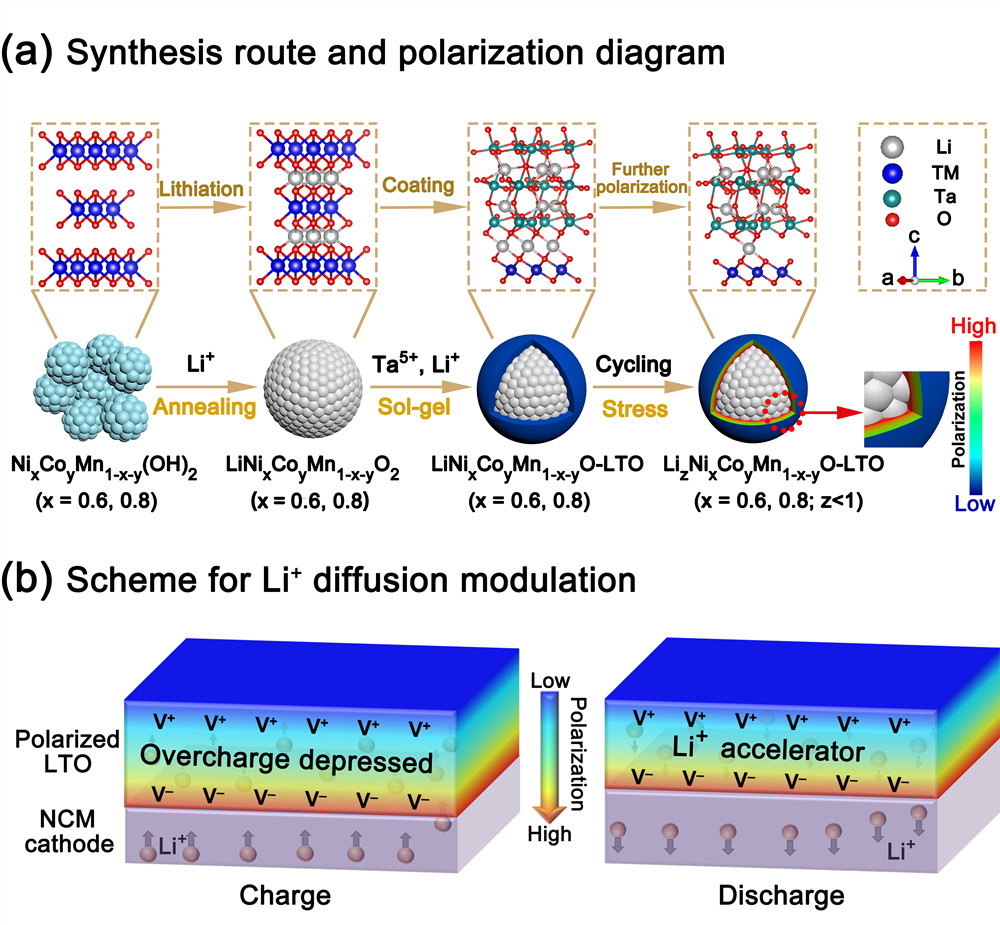Recently, the research group of Prof. Ying Bai from the School of Physics and Electronics has made new progress in the study of the surface modification on Ni-rich materials for the advanced lithium-ion battery. The related paper entitled with "Surface Coupling between Mechanical and Electric Fields Empowering Ni-Rich Cathodes with Superior Cyclabilities for Lithium-Ion Batteries" has been published in the journal of Advanced Science (https://doi.org/10.1002/advs.202200622). The postgraduate Zhongsheng Dai is the first author, Dr. Huiling Zhao and Prof. Ying Bai are the corresponding authors.

Figure 1. (a) schematic diagram of the preparation of LTO-coated Ni-rich cathode and the volumetric change influence of Ni-rich material on the LTO coating layer. (b) the regulating effect of piezoelectric LiTaO3 (LTO) layer on the interfacial Li+ diffusion upon cycling, which effectively facilitates the structure stability and electrochemical performance of Ni-rich cathodes.
Ni-rich cathodes with high energy densities have been considered as promising candidates for advanced lithium-ion batteries, whereas their commercial application is in dilemma due to dramatic capacity fading and structural degradation. To address these issues, this work introduces the piezoelectric LTO layer encapsulating the Ni-rich secondary particles via a facile sol-gel method. Typically, the NCM811-LTO cathode exhibited a capacity retention of 71.8% after 200 cycles under 0.1C, much higher than its pristine counterpart (59.7%). Even under 10 C, the NCM811-LTO delivered a higher discharge capacity of 129.9 mAh g−1, in sharp contrast with the pristine cathode (79.8 mAh g−1). Multi-scale in situ/ex situ characterization, finite element analysis and theoretical simulations manifested that the improvement mechanism of LTO decoration could be attributed to the enhanced structure stability, the suppressed stress accumulation and the regulated ion transportation.
The multi-functions of piezoelectric LTO modification established herein not only provides an effective and pragmatic strategy for accelerating their commercial application through enhancing the structural and electrochemical stabilities, but also paves way to motivate the development of next generation electrode materials in taking full advantage of multi-filed coupling approach, such as mechanical-electric filed coupling, based on the intrinsic physical characteristic of active material as well as artificial interface layer.
The research work is supported by the general project of the National Natural Science Foundation of China, the Zhongyuan Thousand Talents Program of Henan Province, the Henan Overseas Expertise Introduction Center for Discipline Innovation, the Program for Innovative Research Team in Science and Technology in the University of Henan Province, and Science and Technology Development Project of Henan Province.
Advanced Science is a well-known journal owned by Wiley, which mainly publishes the latest scientific research progress in the field of materials science and nanotechnology. The latest impact factor of the journal is 16.806.
Link: https://onlinelibrary.wiley.com/doi/10.1002/advs.202200622
Recoures: School of Physics and Electronics

 Research /
Research Achievements /
Science & Technology /
School of Physics and Electronics /
Content
Research /
Research Achievements /
Science & Technology /
School of Physics and Electronics /
Content


